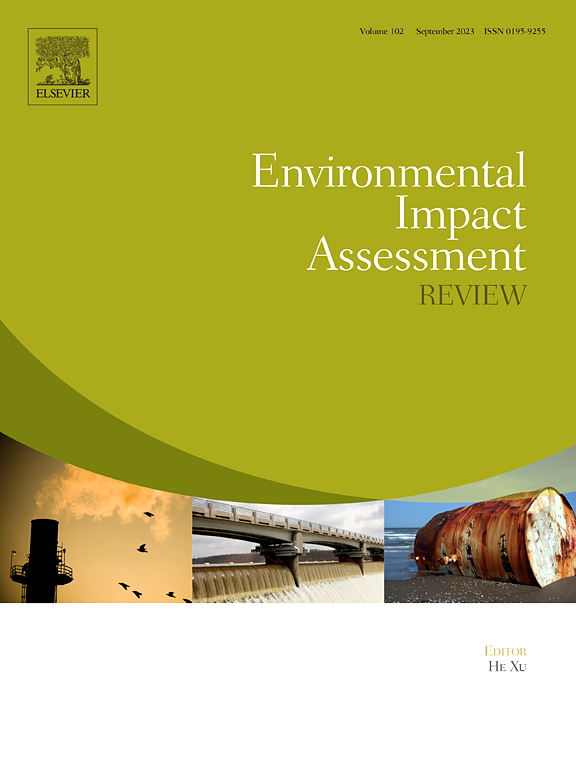Environmental and social impacts of a televisit process: Combined qualitative and life cycle assessment
IF 9.8
1区 社会学
Q1 ENVIRONMENTAL STUDIES
引用次数: 0
Abstract
The healthcare sector is a significant contributor to global greenhouse gas emissions, largely due to resource-intensive care processes. Telemedicine represents an innovative solution for managing chronic patients, with the potential to reduce environmental impacts and improve healthcare accessibility. However, current literature lacks a standardized approach to comprehensively assess the environmental and social effects of such practices. The study aims to overcome current limitations evaluating the environmental and social impacts of televisits as an alternative to traditional in-person follow-up visits for chronic heart failure (HF) patients in a large Italian hospital. The Life Cycle Assessment (LCA) steps ensure an objective and standardized environmental evaluation. Data on social and human-related aspects for preliminary mapping of social impacts has been acquired by means structured interviews. Environmental LCA using the ReCiPe 2016 method quantifies the environmental impacts of one in-person or remote visit process for a one patient, including direct and indirect emissions from transportation, energy use, paper materials and telecommunications. Internal hospital stakeholders were involved in defining aspects of interest for initial mapping of social impacts. Results demonstrate that televisits significantly reduce environmental impacts, particularly in relation to patient transportation. On the social side, stakeholders reported benefits in terms of patient's experience, care continuity, and improvement of clinical workflows. The study emphasizes the necessity of establishing continuous impact monitoring systems to ensure long-term sustainability and efficiency. By demonstrating the environmental benefits and social acceptability of televisits, this research contributes to the development of evidence-based strategies that can enhance both patient care and sustainability in the healthcare sector.
电视过程的环境和社会影响:综合定性和生命周期评价
医疗保健部门是全球温室气体排放的重要贡献者,主要是由于资源密集型护理过程。远程医疗是管理慢性病患者的一种创新解决方案,有可能减少对环境的影响并改善医疗保健的可及性。然而,目前的文献缺乏一种标准化的方法来全面评估这种做法的环境和社会影响。该研究旨在克服目前的局限性,评估电视对环境和社会的影响,作为对意大利一家大型医院慢性心力衰竭(HF)患者进行传统面对面随访的替代方法。生命周期评估(LCA)步骤确保客观和标准化的环境评估。通过结构化访谈的方式获得了初步绘制社会影响图所需的社会和与人有关方面的数据。使用ReCiPe 2016方法的环境LCA量化了一名患者一次亲自或远程就诊过程对环境的影响,包括运输、能源使用、纸张材料和电信的直接和间接排放。医院内部利益相关者参与了确定社会影响初步绘图的利益方面。结果表明,电视显著减少了对环境的影响,特别是在病人运输方面。在社会方面,利益相关者报告了患者体验、护理连续性和临床工作流程改进方面的好处。该研究强调必须建立持续的影响监测系统,以确保长期的可持续性和效率。通过展示电视的环境效益和社会可接受性,本研究有助于制定循证战略,以提高医疗保健部门的患者护理和可持续性。
本文章由计算机程序翻译,如有差异,请以英文原文为准。
求助全文
约1分钟内获得全文
求助全文
来源期刊

Environmental Impact Assessment Review
ENVIRONMENTAL STUDIES-
CiteScore
12.60
自引率
10.10%
发文量
200
审稿时长
33 days
期刊介绍:
Environmental Impact Assessment Review is an interdisciplinary journal that serves a global audience of practitioners, policymakers, and academics involved in assessing the environmental impact of policies, projects, processes, and products. The journal focuses on innovative theory and practice in environmental impact assessment (EIA). Papers are expected to present innovative ideas, be topical, and coherent. The journal emphasizes concepts, methods, techniques, approaches, and systems related to EIA theory and practice.
 求助内容:
求助内容: 应助结果提醒方式:
应助结果提醒方式:


